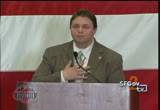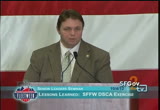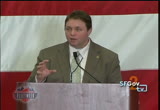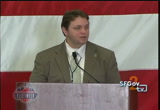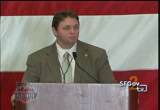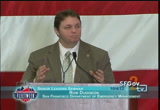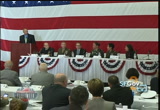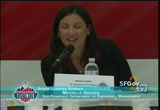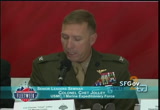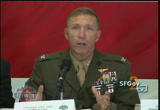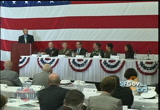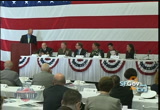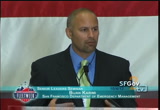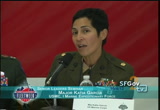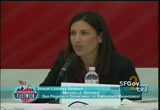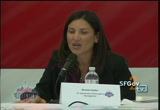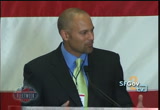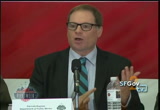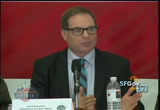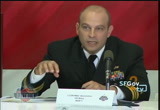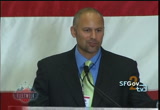tv [untitled] December 29, 2012 12:30am-1:00am PST
12:30 am
that's what this is really about. in my opinion it is incumbent upon us as a local community to understand where our gaps, are understand what we will need in a time of crisis and understand how best to dovetail with the resources coming in. the military does what the military does and they can be incredible flexible. they can bring a lot of stuff to bear that we can never even imagine. it's our job to understand where those hard stops are for them and how they are best suited, because we can build out our plans in anticipation of that. in the case of, say, medical surge, we can look forward and say this is what we're going to need. we're going to need help with patient movement. we're going to need help with the chronickly ill because by the time the military arrives, a day or so into it at least, even with the best of plans, we're going to have to start figuring out how do we manage
12:31 am
those chronic patients and you know what, moving stuff is what they're really good at. moving patients in particular, they are amazing. so we start to look at things like that. as we look through this and we start to talk, remember it's beyond the scenario, it's the relationship. this year we decided to test, based on last year's lessons, last year the table top on the broad topic of medical surge, generated a top of lessons learned. a lot of areas to explore. one of the biggest ones was, here's a surprise for you, interoperatable communications. it always works out that way. the other was command control. how do we operate together at the field level. it's one thing to have all the executive staff working together, it's another thing to take our middle managers from all the organizations and throw them into a situation where they have to work together. because the way we work together on the
12:32 am
civilian side and the way you work together on the military side is slightly different. but we're all very intelligent individuals out there and they know how to solve problems. again, it's our job to understand what the limitations are. it's our job to understand that what is given in terms of giving an asset an order and we may look at it and say, hey, things change, we need to go over there now. that may or may not be something our military counterparts can do. we have to understand that. we have to understand that in order to maximize the efficiency and efficacious of that resource. this year we did a command of control exercise and we did a communications drill and we did them simultaneously. they were sort of related, sort of not. one was, we brought out the
12:33 am
coms people and said, play, we set up 3 points around the city and said play, make this stuff connect. see if we can talk to each other. we had the national guard above us in a helicopter, even though it was really foggy, they didn't see much, but they demonstrated proof of concept that they can connect the video feed. we learned there are limitations in things of band width and video feed that i'm not qualified to talk about, i'm strictly a push to talk guy. we know as a city when the earth moves, things fall, we get a lot of rubble. that's going to be one of our critical, critical things we have to do. we have to be able to move material and personnel and one of the ways we're going to be doing that is how do we actually get the debris off the road so we can put things back to work. so that was the command of control exercise.
12:34 am
we had the marine corps, the navy, and the national guard all working with our department of public works figuring out how would they work together. we didn't give them a lot of coaching, we just kind of put them in a tent and said here is your scenario, here's some problems, and we wanted them to work it out and they did. so it was a very successful year. that's what we did as far as the field exercises. next year i don't know what's next, we're going to explore the lessons learned from this one, we've already learned a bunch, they're going to talk about this shortly then learn what are the next scenarios we can challenge people with. it probably won't be the same ones. we are building the institutional relationships and getting beyond the scenario. it's not just about the heavy equipment operators, it's about city of san francisco staff and departments understanding how the military works and giving the military a chance to work
12:35 am
with the civilian authority in a non-crisis environment so that when they have to do it anywhere in the world, they've got one extra training day. that's the way we look at it, it's all one extra training day. you add all that up, we have a lot better chance when we need it. with that, i'm going to bring up dejon and take over the panel and i'll talk to you shortly. >> thank you, rob. the panelists we have represent a broad group of participants, some of them participated themselves and some of them had individuals in their organizations participate. and i want them to start with an introduction of who they are, a little bit about their own background, so you understand the lens they were looking through when they were providing some of their answers today. starting with our 3 panelists that were part of our command and control exercise then we'll hear from our 3 panelists that were in our communications drill. >> lieutenant commander mike
12:36 am
kress, operations officer at naval beach group 1, i was a coach during the exercise. we supported the exercise with 3 subject matter experts from amphibious construction battalion 1, their expertise is in route clearance, they actually played in the exercise and i was the coach for the exercise. >> good morning, i'm colonel alley, marine operations officer for the marine expedition briged. i was responsible for the planning and (inaudible). >> good morning, my name is (inaudible), superintendent pe department of public works, i'm responsible for street cleaning, trees, landscaping through the city. on the day of the incident i was the operations chief at the incident command poach at ocean beach. >> good morning, i'm captain
12:37 am
houston with the california national guard. i'm with first marine briged. i've been coming to san francisco since may for the planning efforts and i got to participate in the com drill with 6 marines and we were dispersed from all 3 different sites. >> good morning, everybody, my name is michelle geddis, i'm with the san francisco department of emergency management, i'm responsible for the project management ofrs and one of our major programs is the interoperatability program. so i was more than delighted to be part of this com exercise, i was able to be an evaluator at the ocean beach location and we have a lot of lessons learned to talk about. thanks. >> one of the challenges that
12:38 am
we have in civilian and also you as military is that common operating picture. how do we make sure that all of our resources in the field, back in the command post, have the same operating picture and we can ensure that we have an unity of effort of everyone. and with the command and control exercise that we started with, this was one great opportunity for the military and the civilian groups to work together. so i'd like to hear from our c2 exercise participants how that went. colonel jolly, will you tell us about that? >> from our perspective we had the right people in the right place. as we saw during the medical exercise yesterday, ocean beach has a good many advantages for both the city of san francisco and for the military to facilitate disaster relief. i would say during the exercise also as many people have pointed out, building relationships was the highlight of the day and the planning
12:39 am
process. we learned a lot about each other, capabilities and processes. i would also say that during the day we focused on how a command post should operate. within the marine corps and the military, we talk about commander's sbept. that gets us past the flow chart diagram or the policy question, it gets to what truly is the outcome that the commander or the mayor in this case is looking for, and that allows everybody in the room to think beyond just the specific problem but to more the holistic solution to the outcome that we're looking for, in this case route clearance. we talked about how to filter information that comes into the coc my experience in disaster relief is the amount of information coming into a command post is overwhelming so processes have to be put in place so that the filter allows
12:40 am
emergencies to be addressed appropriately, priorities to be resourced appropriately, and the routine to be put into something so that everyone is aware of it and if it becomes, it changes to one of the other categories it can be addressed. and, last, we talked about how to share that information not only amongst ourselves within that particular command goes, but across the city, outside of the city up to the state and further if resource shortfalls do occur. we talked about a mapping process but more importantly than just that process, really the -- go back to my first point -- is the intent. if we start with a plan that explains what the priorities are, everybody is focused on those priorities. so if the map shows those critical pathways that have to be opened, which i saw yesterday during the medical exercise, the medical community knows what those routes are,
12:41 am
they know which one have to be opened in order for citizens to get to those critical places. once that's posted up in the coc, we're all focused on that priority. identifying where those challenges are is really the challenge to understand that command element, command post, what the priority is and to be able to transmit that to the field where the resources are and then, if need be, to transmit the resource shortfalls beyond that. overall it was an outstanding experience. >> i'll jump in here. so this concept of common operating picture is one of the biggest takeaways for me and i think the city as we did this exercise. now, big concept, easy to implement. as rob was talking about, we're out at ocean beach, we're in a tent, we're 72 hours in, we don't have a lot of equipment, all i really needed to have was a nice map and to bring everyone to that
12:42 am
map so we would have that common operating picture so everyone understood what we were doing. two things that were brought to me when we did our after action talk. one was a shared mission. folks in the military, it was clear to me, and we had a great working relationship, they are going to do what we need to do from jump street. they are just going to make it happen. but it would have been important to me, i could have used that vehicle, the common operating picture, to show what that mission was. why are we clearing specific routes? we often in the city jump right into our projects, we do this day in and day out, i know which routes have to be cleared, but if i had used the common operating picture down at ocean beach and showed them from the military why we were clearing certain routes, again we would have gotten it done. it was brought to my attention to do that, to have the
12:43 am
setting, it talk about the common operating picture so we can all see it, then we started to breathe at that place. it changed everything. one of the biggest things for me that i went back to, i need that in my go bag, in my package as i go out to an incident is make sure i have something that works for everyone, not just the city folks, but everyone there working with me on the ground. >> i don't have much to add to that. i agree 100 percent with all that. that was probably the common operating picture was probably where we got our, most of our lessons learned from. if we had updated that a little bit better, we would have been able to track the resources a little bit better. we would have been able to allocate them a little bit better, and i was pushing my guys to actually add more information into that common operating picture so any time anybody came into the incident command post, whoever walked in there could ipbs stabilitily
12:44 am
get awareness of what people were where, what equipment is being used and where, how long it's been there. that was our biggest lesson learned and we've taken steps to ensure we use it in the future. >> as rob mentioned, concurrently but not connected was the communications drill. like rob, when i key up my radio i just expect it to work and when it doesn't, i'm not quite sure what to do. that's why when we bring in the communications experts they are the ones who are going to make all the different systems talk to each other. and a lot of the grant money that we receive in the bay area is for interoperatability, getting all the radios for all the different emergency responders to work together. and in the exercise we did in 2011, when we were discussing the medical surge, a lot of times we would just kind of
12:45 am
wave our hand and say, oh, yeah, people will talk together and the people why we really wanted to seize on thawas let's see if we can actually do that. and that's why we ran our communications drill. the idea was to connect voice, video, radio and data back and forth to see if we can talk back and forth. one thing i learned was we brought the military on to the city's network. one of the things i look forward to next time is having us go on to the military network because it's highly likely our city network will be down, so we will be relying on them. so from our communications participants, you encountered some challenges but you were able to work through those. i'd like to hear from you, what were some of the challenges you ran into and how were you able to overcome them and i'll start with major garcia. so one of -- we're going it talk about challenges but also the good things. i want to
12:46 am
mention that throughout this planning effort we've been planning since may but we literally got on the ground probably monday, most of us, and then on tuesday we threw all our equipment into different sites and turned it on and we had connectivity, one way or the other. i think one of our challenges, i know for my group, i was out at pier 96, we were supposed to connect into the data network and my marines had a very small footprint, small suitcase, we weren't able to actually connect to the cloud and be able to send reports via web voc using an ip network. the good thing, however, how we overcame that challenge and i think it was a very good planning consideration, was that at each of the sites we had an element either from the national guard or air national guard or the department of public works acu one thousand
12:47 am
van and they pretty much made up the backbone of that network. the point i'm trying to make is we had redundancy at each site and then small unplanned events were not a factor. one way or another we were able to send our reports through. this is a starting point for working in san francisco. we could have probably done more analysis of the terrain that we're working in terms to identify those black holes for cops, those black areas. so we learned a lot. i think a lot of this has been captured in the afteraction and i think if we have another iteration next year to definitely have a good starting point. >> we brought from the california national guard, we brought our quick reaction area force and we brought our ic for you so we had 3 different com
12:48 am
spans that are cross banded, which is an opportunity that not all dod assets have. they have civilian internet and that is their primary mission, is to cross band between the military and civilians. it worked very well because the command and control element were on an ip common operating picture. some of our challenges were the radio communications. we got cross banded with san francisco but bringing in commercial satellite down to the marine force that would be on the ground was one of the challenges that we had to work through after the event. it was successful but it's something that in planning in an emergency we need to make sure that the correct satellite assets are down to the end users, the people on the ground.
12:49 am
>> hello, so we had a lot of success i think we talked about, at least at the ocean beach location we were able to get the ip internet communications with web eoc, we had really good telephone communications, you know, with our blackberries, our smart phones and some satellite phones. i think from at least the city's perspective our biggest challenge was the lan communications. we've worked really hard to improve interoperatability communications with the city. if we were needing assistance from oakland police department and they needed to come into san francisco, we have a really good structure to be able to implement interoperatable communications over the radio. but with the military this is a whole new set of radio frequencies, radio technology, even before the planning we
12:50 am
didn't know what they had. it took us several planning opportunities and meetings to flush through some of that information and one of the biggest take aways for us, as a city we're required to have a tactical interoperatable communications plan. it describes how you interoperate in an emergency or an event within the city as well as regional partners. we don't have that with military and i think that's one of the biggest take aways, we need to really flesh out a document so we have captured who our contacts are, what technology they are going to bring to the table and start that initial planning from the get-go. we also had some technical challenges with land mobile radio. you know, we have the coverage issues, but we were stationed at the san francisco police department command van, i had some very sharp people there who were able to work
12:51 am
through a lot of those interoperatability issues so a huge thank you to the police department and also the fire department and sheriff's department were also there able to provide us with otherality gnat communications paths, only channels we were able to use for the exercise. it was a really good team effort by the city, by the city departments. >> general myat mentioned this morning, it's a common theme, the ability to meet the other people you are going to be working with or at least their agencies, how they do things, something i want to hear more about and i'm going to start with you because this is your first opportunity to work with the military. describe that experience, often times words and nomenclature can be new for all of us. >> right off the bat, the military shows up at ocean beach and they were ready to work and ready to work regardless of how our operation
12:52 am
was going. i talked about the cop, after our first briefing they said it would be better during the map there, but not during the first meeting, there was no interruption, no confusion, no conflict, they were ready to work with us whatever we needed. three things i saw were things we could work on. the idea of a common lexicon, we in the city, we will call say sar chavez street army street and back and forth. if you are not from san francisco and you are coming from somewhere else, as many of the folks were, they didn't necessarily know what we were talking about there. we're moving through our language, moving tlau our acronyms. it would have been very simple for me to come with a one pager even dealing with the slang, drop that on the table connected with the cop so everyone knew what was going on. that would have been helpful. that was the first one where i saw an area where
12:53 am
we could do some good work. the second is typing, the concept of when i unload a front end loader that i also include what personnel will be with that equipment. we call it typing, many of you know the same thing, you know about it. the military came with all their equipment typed perfectly and it came to us right there. we didn't have that. i'm being very candid with all of you. we didn't have that coming in. so what we did was spent time telling them how many personnel come with each truck, each piece of equipment we have. the benefit of that is i saw the great relationship between the military and the staff walking through the equipment, understanding where the gaps were on our side and their side as we started ordering up equipment to bring it to the city. which is absolutely going to happen, we will put orders in early, see it arriving within a few hours, within a few days, but knowing what each other has would be
12:54 am
helpful. easy to solve. this last one around shared mission, that was told to me and i really get it. you know, we're moving forward with a game plan and we hit the ground there in ocean beach and i've got a map and i know exactly what streets have got to be cleared, which ones are in order. i know exactly what has to be done to get the streets open, get the routes open, getting emergency equipment in, getting hospitals open. how easy it would have been to bring that shared mission even offline with some folks, why are you doing this street, so everyone could get on board and be a part of that same mission. we set up the operations center, the incident command post, we kind of used an ics type structure in settinging it upment and i led with a lot of folks that i knew that knew how to run that. next time i would think more about the military folks by asking a question, who has experience being a plans chief, who has experience being
12:55 am
an operations chief, bringing more of the military in who were ready to work and knew what to do, as part of our family, could have had more of them in leadership positions bringing the team closer together. it was a great experience for me. it's absolutely going to happen. we hope we would have that great working relationship and we expect we would. we can take this to another level and be working much more closely with the department of defense, all levels with our military which it was a strong working relationship there and these were just some of the take aways for me. interested to hear what others have to say about that. but again, i came out of there feeling very positive and with a few punch list items that wopt take much for the city to do but that we can put in place and we will be that much stronger when the earthquake happens. >> from our perspective it was very seamless, cooperative. we
12:56 am
understood the cq structure right there out of the gate, we're there to support. we fell in under the department of public works rep and we have some training in ics, there's dod instructions, cnic instructions, they are not our operational chain of command but we all work on bases so we're there to support them also if needed. so we do have some understanding of ics. our challenge is to become more familiar with the ics system so we're more fopl when we get into a system to support that. there are planners that get that training but we need to take it a level down so the lno's that are going to go to the incident command post also have a lot of ics experience. we had enough to get by so when they did call an objective
12:57 am
meeting or a tactics meeting, we knew what he was talking about. when he was developing an action plan, we understood that, but we could have benefited more and we take this on board, too, to get more people trained up at that next level down. >> from my experience as the exercise, i would agree with everybody here. the first thing we have to do is understand, to understand what the priorities are so the first thing we need is an orientation. not just a map orientation, although that's very helpful, we're not that familiar with san francisco, where the hospitals are, where the priority routes are, but we also need a quick orientation what the priorities are. where is the focus of effort so we can orient ourselves and our capabilities towards that. second thing we need is to
12:58 am
understand the intent. what is the priority, where are they and that also keys us to what capabilities we might be able to focus on. of course the third thing we need to know what the resource shortfalls are. that will allow us to determine what kinds of equipment we need to put towards that. but what i saw in the exercise was a good information flow and an atmosphere of a team effort at the location at ocean beach. >> thank you. thank you, all. when we have an vent in the future and we know it's going to happen, we just don't know when, i sometimes tell my team we're one day closer to the next disaster. i don't know when it's going to be, but we're one day closer. when that happens it's unlikely that the people we exercised with are actually going to be the people who are responding. so knowing that, what are the top 3 things that
12:59 am
you might share, your elevator speech, if you will. rob mentioned institutional knowledge. what do you want to take and give to someone else when they come to san francisco? and this is for our military participants. captain houston? >> my recommendation, dod element coming into a city incident, is, one, bring a list of your communications capabilities, your frequencies and documented in its capabilities, not necessarily the acronym of your branch. we came in with our hf radios and lucas took that information, he understood it and put it on to his ics form. so that's the no. 1 priority that i would say to bring in initially. 2, i would say understand the primary situational awareness. in the military we call it a pay plan or ar
119 Views
IN COLLECTIONS
SFGTV2: San Francisco Government Television Television Archive
Television Archive  Television Archive News Search Service
Television Archive News Search Service 
Uploaded by TV Archive on

 Live Music Archive
Live Music Archive Librivox Free Audio
Librivox Free Audio Metropolitan Museum
Metropolitan Museum Cleveland Museum of Art
Cleveland Museum of Art Internet Arcade
Internet Arcade Console Living Room
Console Living Room Books to Borrow
Books to Borrow Open Library
Open Library TV News
TV News Understanding 9/11
Understanding 9/11